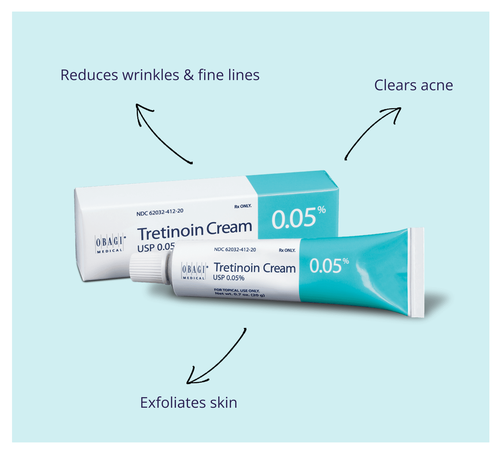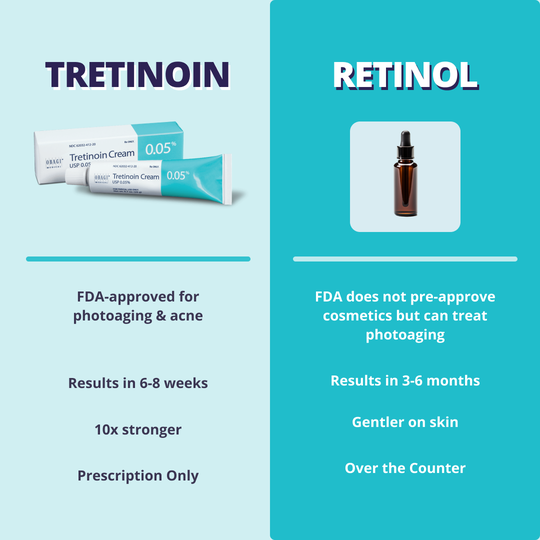What are Tretinoin and Retinol?
Both tretinoin and retinol are derivatives of Vitamin A and belong to a broader category of compounds known as retinoids. But while they may come from the same family, they differ in their strength, usage, and effects.
- Tretinoin: Tretinoin, often recognized under brand names like Retin-A and Stieva, is a prescription-strength retinoid. It's primarily used for acne treatment but has gained recognition for its benefits in addressing wrinkles and dark spots. Some common brands include: Stieva, Retin-A Micro, Refissa, Retin-A, Retin-A Micro Pump, Tretin-X, TRETIN-X Cream Kit, Atralin, Renova, and Avita
- Retinol: This is a gentler, over-the-counter version of a retinoid. Often used in many skincare products, retinol targets fine lines, wrinkles, and age-induced dark spots.
How do Retinoids work?
Retinoids play a crucial role in various skin treatments, thanks to their ability to regulate cell growth and affect gene expression. At the cellular level, retinoids work by binding to specific retinoic acid receptors in the skin. When activated, these receptors:
- Boost Collagen Production: This helps diminish fine lines, making the skin look plump and youthful.
- Increase Cell Turnover: By shedding the outer layer of dead skin cells and producing fresh new cells, retinoids can unclog pores and give the skin a smooth appearance.
- Reduce Melanin Production: This results in fading dark spots and evening out the skin tone.
- Regulate Sebaceous Glands: For those with oily skin or acne, retinoids can regulate oil production.
Is Tretinoin Better Than Retinol?
The main differences between tretinoin and retinol lie in their availability, potency, and how they work:
- Availability: Retinol is found in a wide variety of skin care products available over-the-counter (OTC), while tretinoin is stronger than retinol and is available only by prescription in Canada.
- Potency: Tretinoin, also known as retinoic acid, is the most biologically active form of retinoids. After application, retinol is converted to retinoic acid. With a potency of around 10 times greater than retinol, tretinoin offers more powerful effects than retinol.
- How they work: Tretinoin works more efficiently because it is already in the form of retinoic acid, which is the active form that can have beneficial effects on the skin. On the other hand, retinol needs to be converted by enzymes in the skin into retinoic acid to have any beneficial effects.
Battle of Benefits: Acne, Fine Lines, and Wrinkles

- Acne: Tretinoin has a potent effect on acne-prone skin. It increases cell turnover, unclogging pores and making them less visible. Retinol also aids in acne treatment, but it may take longer to see visible results.
- Fine Lines and Dynamic Wrinkles: Retinol is a favorite for addressing the early signs of aging, like fine lines. However, for deeper dynamic wrinkles and more mature skin, tretinoin's potency can offer quicker and more dramatic results.
- Dark Spots: Age and sun exposure can lead to hyperpigmentation. Both tretinoin and retinol are effective against these dark spots, with tretinoin being slightly more potent.
So, whether tretinoin is “better” than retinol can depend on your specific skin needs and concerns. Tretinoin tends to be more potent and can deliver results faster, but it may also cause more side effects. It’s generally recommended to have a conversation with a dermatologist to decide the best treatment plan for you.
Dosage & Administration
- Tretinoin: Adherence to your dermatologist's dosage instructions is crucial. Many individuals begin with a low concentration, gradually increasing the strength as their skin becomes more tolerant. Rather than daily application, it's often recommended to commence with one or two nights a week until the skin adjusts.
- Retinol: Since it's milder, there's a bit more flexibility. However, it's always a good practice to start with lower concentrations, especially if you're new to retinoids.
Should Retinol & Tretinoin Be Used Together?
While you can use both retinoids together, it's not recommended as they act on the skin in similar mechanisms essentially doing the same job. Combining them can potentially accelerate side effects and increase the skin's sensitivity.
How Long to See Results?
The time it takes to see results can vary depending on the specific retinoid used and its strength:
- Retinol (Over-the-counter): Being milder, retinol users may need to wait up to 3-6 months for noticeable results. The initial stages might see a bit of skin irritation or "purging" where the skin might break out before it gets better.
- Tretinoin (Prescription-strength): Depends on the concentration but in general, its potency can offer quicker results, typically within 6-8 weeks. However, the initial phase might include more pronounced side effects like peeling and redness.
In both cases, it's crucial to remember that consistency is key. Regular, consistent use ensures the best outcomes, and results are often progressive – they get better over time.
Strengths & Concentrations
When comparing the two retinoids, it's important to realize that retinol 0.25% is not the same as tretinoin 0.025%. Tretinoin 0.025% is stronger than 1% retinol which is the highest concentration you can get without prescription. It's generally believed that there's a 10% conversion rate at each step: 1% retinol converts to 0.1% retinaldehyde, which in turn converts to 0.01% tretinoin. So 1% retinol is about the same as .01% tretinoin, however this conversion efficacy can vary among individuals. Some patients may exhibit higher conversion rates to retinoic acid, while others may convert less efficiently. For those with sensitive skin, it's recommended to start with lower concentrations to give your skin time to adjust.
Common doses ranked from lowest to highest are as follows:
- Retinol 0.25% (2X) to 0.3% (3X)
- Retinol 0.5% (5X)
- Retinol 1% (10X) and Tretinoin 0.01%
- Tretinoin 0.02%
- Tretinoin 0.025%
- Tretinoin 0.05%
- Tretinoin 0.08%
- Tretinoin 0.1%
Side Effects: What to Expect
With greater potency comes a heightened possibility for side effects. Tretinoin users often report redness, peeling, dryness, and a stinging sensation, especially when they first start the treatment. Over time, the skin usually adapts.
Retinol users might experience similar side effects, but they tend to be milder. If you have sensitive skin, starting with retinol might be a better option.
Common Mistakes & Mitigating Side Effects
- Start Slowly: If you’re new to retinoids, begin with a lower concentration and increase it gradually as your skin builds tolerance. Also, consider applying it every other night or even every third night initially, then gradually ramping up as your skin adjusts.
- Application Technique: After cleansing, wait at least 20-30 minutes before applying retinoids. This ensures your skin is completely dry, reducing potential irritation. When applying, a pea-sized amount is usually sufficient for the entire face.
- Moisturize: Applying a moisturizer after your retinoid can help combat dryness. Opt for a non-comedogenic product to prevent clogging pores.
- Sun Protection: Retinoids can make your skin more sensitive to the sun. Always apply a broad-spectrum sunscreen with an SPF of at least 30 every morning, even on cloudy days. Wearing a wide-brimmed hat can offer additional protection.
- Avoid Mixing with Other Potent Ingredients: When starting with retinoids, avoid using products containing other potentially irritating ingredients like benzoyl peroxide, salicylic acid, or alpha hydroxy acids. Introduce one product at a time to monitor how your skin reacts. Tretinoin is already a powerful exfoliant. Concurrent use with other aggressive exfoliants can result in excessive skin exfoliation and associated irritation.
- Hydrate: Drinking plenty of water helps maintain skin hydration from the inside out, potentially mitigating some of the dryness associated with retinoid use.
- Gentle Cleansing: Choose a mild, hydrating cleanser over one that might strip your skin. Avoid scrubbing or using physical exfoliants which can further irritate the skin.
- Buffering: If you find direct application too harsh, mix your retinoid with a moisturizer to "buffer" its strength, making it gentler on your skin.
Addressing Initial Breakouts or "Purging"
It's common for users to experience a flare-up of acne when they first start using retinoids – this is often referred to as "purging." This occurs as the retinoid accelerates skin cell turnover, bringing existing microcomedones (early acne) to the surface faster. While it can be discouraging, remember:
- This is temporary, typically lasting 2-6 weeks.
- It's a sign the retinoid is working.
To combat this, continue with the retinoid use, ensuring you’re using the correct dosage and applying it properly. If the breakout persists or seems unusual, consult with a dermatologist.
Do you have to use retinoids forever?
The use of retinoids is not a lifelong commitment. The decision to continue using retinoids depends on individual goals, skin tolerance, and the specific effects desired. However, the associated anti-aging benefits are typically maintained only with continued use.
When retinoid use is discontinued, the skin gradually returns to its original state over time. This is because retinoids work on the principle of active skin renewal and collagen stimulation, which persists only as long as the treatment is applied. The reversal of benefits after stopping retinoids isn't immediate but gradual. The skin may eventually return to its baseline state in terms of aging signs.
Do Retinoids cause cancer?
The concern about whether retinoids cause cancer arises from their potent biological effects. However, current scientific evidence suggests that retinoids do not cause cancer. In fact, some studies indicate that retinoids may have protective effects against certain types of skin cancer. For example, retinoids like acitretin and bexarotene are used in the treatment of specific skin cancers, demonstrating their potential anti-carcinogenic properties.
The confusion might also stem from the fact that retinoids can increase skin sensitivity to sunlight, which, without proper protection, could elevate the risk of skin cancer. However, this is a consequence of increased sun sensitivity rather than the retinoid itself inducing cancer.
When are Retinoids not a good idea?
- On Irritated Skin: Do not apply tretinoin to windburned, sunburned, dry, chapped, irritated, or broken skin. Also avoid using this medication in wounds or on areas of eczema. Wait until these conditions have healed before using tretinoin1.
- Allergy: You should not use tretinoin if you are allergic to it or to other retinoids (such as Accutane, Retin-A, Renova).
- Certain Health Conditions: Tell your doctor if you have ever had high cholesterol or triglycerides, liver disease, or a blood clot or stroke.
- Breastfeeding: Do not breastfeed while taking tretinoin.
- Certain Skin Types: Topical retinoids may irritate your skin if you are prone to dry skin or have skin allergies.
The Age Factor
When should you start incorporating these into your skincare regime? There's no one-size-fits-all answer, but many dermatologists suggest introducing retinol in your late 20s to early 30s, especially if fine lines are a concern. For more aggressive treatments or more pronounced skin issues, tretinoin might be introduced later.
How much does each cost?
The cost of retinol varies significantly depending on the brand and formulation but can range from $15 to north of $100 for a 30mL tube which lasts 3 to 4 months depending on usage.
Tretinoin is around $14 - $18 for a 30g tube, which also lasts about 3 to 4 months.
Which is Better?
Tretinoin and retinol, while both from the retinoid family, serve slightly different purposes in skincare. If you're aiming to combat severe acne, dynamic wrinkles, or you want faster results, tretinoin might be your pick. For those looking for a gentler introduction or to address early signs of aging, retinol could be the way to go. As always, consult with a dermatologist before making decisions about your skincare regimen.
Disclaimer: This blog post is intended for educational purposes only and should not be taken as medical advice. Always consult your healthcare provider for personal health concerns.
